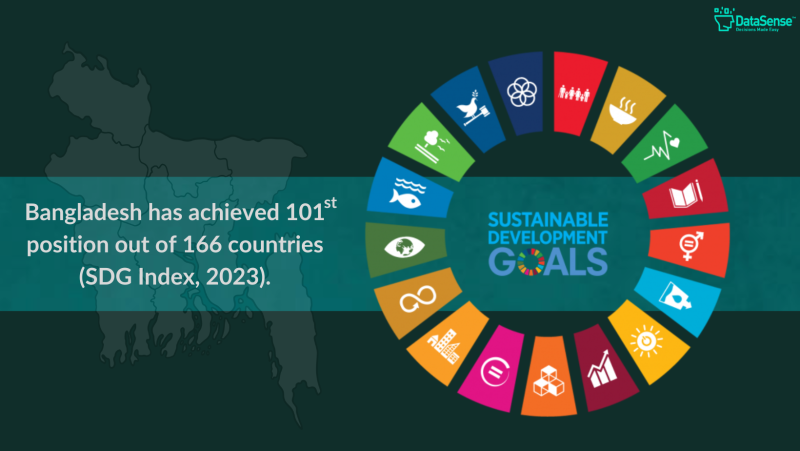A Guide to Geographical Indication Products: From the Lens of LDC Graduation of Bangladesh

Author: Khairun Ferdous
Graduation from LDC status is indicative of a country’s progression toward economic and social development, enabling its transition to middle-income status. The most recent triennial assessment conducted by the Committee for Development Policy (CDP) has confirmed that Bangladesh has met the criteria for exiting the LDC category, including the three defining criteria of per capita Gross National Income (GNI), Economic and Environmental Vulnerability Index (EVI), and Human Assets Index (HAI) (The Financial Express, 2021).
As per the guidelines, Bangladesh was required to possess an annual per capita income of $1,230 to graduate from LDC. In the year 2020, Bangladesh’s annual per capita income stood at $1827, surpassing the required threshold. Bangladesh also exceeded the necessary rating of 66 points in human resources with a score of 75.3 in the same year. However, in terms of Economy and climate issues, countries are often categorized based on their performance and development indicators. In this context, a score of 36 is typically associated with the classification of an LDC, while a score of 33 signifies a country’s status as a “Developing Country.” Bangladesh, with a score of 25.2, clearly falls within the category of an LDC.
Nonetheless, owing to the Covid-19 pandemic, the Government of Bangladesh requested a two-year deferment of their graduation from the Least Developed Countries category, which was initially scheduled for 2024. This implies that Bangladesh will transition to the Developing Country category by the year 2026. Additionally, officials of Bangladesh have requested an extension of the LDC privileges for an extra three years, which would result in Bangladesh’s graduation to the Developing Country category by 2029 (Talokder, 2023).
As Bangladesh moves towards graduation from the category of least developed countries, the potential consequences for its geographical indication products could be of great significance. The deployment of Bangladeshi Geographical Indications could serve as a mechanism for promoting the nation’s brand image and, in turn, facilitate the expansion of its merchandise trade (Wardad, 2012).
Understanding GI:
A Geographical Indication is a type of collective intellectual property that denotes a product with a unique geographical origin and possesses qualities, prestige, or unique characteristics that are inherently linked to its source. It serves as a symbol to aid consumers in discerning authentic products and making informed decisions regarding their value, quality, and authenticity (Vecchio, 2020). Generally, geographical indications (GIs) are identifiers used to signify the account of excellence and distinctiveness, which is a fundamental attribute of its inception in a particular geographic region, zone, or nation (Aggarwal et al., 2014).
International treaties have acknowledged the GI concept. The first multilateral agreement to mention “indications of source or appellations of origin” was the Paris Convention (1883). Indications of the source are specifically addressed in the Madrid Agreement for the Repression of False or Deceptive Indications of Source of Goods (1891). The Lisbon Agreement allows for AI for GI products among its signatory nations. The most recent agreement that offers GI protection is the WTO TRIPS Agreement. (Yusuf & Burhan, 2015).
Benefits of GI Products on the Economy
It is undeniable that the developing and least developed (LDC) nations have a wealth of agricultural resources, locally made handicrafts, and traditional knowledge (Vittori, 2010). Therefore, GIs may be effectively used as a vehicle of public policy for sustained economic improvement, particularly with regard to a rural development program (Vecchio, 2020). Additionally, it may be utilized to transform makers or crafters of common goods from LDCs and emerging nations into prosperous exporters with well-established enterprises and a great deal of opportunity for profit distribution (Airriess, 2019).
Globalization has made it increasingly difficult for producers to distinguish their products from those of their competitors. However, Geographic Indication (GI) provides a solution to this problem. By leveraging GI, producers can differentiate their unique products from similar competing products, establish brand and goodwill of local products, fetch premium prices for such products, and increase their sales/export by safeguarding the reputation of these products (Rahman, 2012). One of the significant aspects of GI products is that it creates a monopoly leadership in the international market.

Source: (Giovannucci et al.,2009).
Impact of LDC Graduation on GI products:
LDC graduation can bolster trade opportunities, offering better access to international markets. By registering products as Geographical Indication (GI) products, local entrepreneurs can establish a brand and receive acknowledgment for their product as a distinct item. As a result, GI contributes to the marketability of rural and traditional products worldwide at a higher price, which may be viewed as an alternative approach to community development for producing GI products. Additionally, GIs maintain a region’s identity in an ever-increasing globalized world (Yusuf & Burhan, 2015).
Social Impact
Employment Opportunities: LDC graduation can positively affect employment rates, especially in the production of GI products generates employment opportunities for the local community. GI products have the potential to serve as a source of income for the inhabitants of the region.
Poverty reduction: As GI products generally originate from agriculture, fisheries, handicrafts, etc., and are produced by the rural community, the economic advantage gained through commercializing the GI rights accrues to the poor & the LDC graduation enhances the commercialization of the products. GIs thus help to reduce poverty and stimulate regional economic growth.
The Harsh Reality of the Impact of LDC Graduation on GI Products in Bangladesh:
Although Bangladesh is on its way to achieving its LDC graduation in no time, the existing absence of global demand for GI products has prevented local businesspeople from reaping any benefits. The insufficient marketing of the country’s GI products is a significant factor contributing to the failure to capitalize on the certification. Additionally, financial support has not been provided to those who produce GI products to enhance their export capacity. So far, no business has been able to export hilsa or black tiger shrimp with the GI tag. In a The Daily Star report (2023), Sukanta Halder, and Abrar Hossain upheld that according to Shafiqul Islam, principal scientific officer of the Rajshahi Fruit Research Station, and Munjer Alam, secretary, – “not a single GI tagged Fazli mango has been exported as of yet”. (Halder & Hossain, 2023)
The report observes that the commercialization of the country’s GI products is still in the early stages. A report by Kaler Kantho (2023) also highlights the same fact that there is still no significant increase in the exports of those GI products despite getting the status of LDC-graduated country (Kaler Kantho, 2023). According to a study, Dhakai Jamdani, the very first Bangladeshi GI product, and its diversified products, including saree accessories, artwork, bags, home decor, luxurious curtains, and cushion covers, had no record of export in the Export Promotion Bureau of Bangladesh’s database as of 2021 (Biswas & Rahman, 2022).
Recent Initiatives for Enhancing the GI Market in Bangladesh:
The government of Bangladesh is taking significant initiatives to utilize the LDC graduation status on enhancing the market value of GI products. Among all the recent initiatives, most significant is that in a partnership with BSCIC, the Turkish Cooperation and Coordination Agency (TIKA), and the Aspire to Innovate-a2i, a ground-breaking E-Commerce Facilitation Center has officially inaugurated at BSCIC Jamdani Shilpa Nagar in Narayanganj with the aim of revolutionizing and growing Bangladesh’s renowned jamdani industry both domestically and internationally (a2i, 2023).
The advancement of Bangladesh from its LDC status marks a momentous achievement, which highlights the nation’s economic progress and its potential for further development. Considering this journey, it is crucial to acknowledge and utilize the possible benefits of Geographical Indication (GI) products. Through the protection of local traditions, promotion of sustainability, and utilization of global market access, Bangladesh has the opportunity to harness its GI products as potent facilitators of economic advancement and cultural preservation. Given the growing consumer appreciation for authenticity and origin, the endorsement of GI products can have a pivotal role in ensuring a thriving and sustainable future for Bangladesh.
Reference:
A2i. (2023, July 26). Inauguration of E-Commerce Facilitation Center at BSCIC Jamdani Palli Nagar in Narayanganj for the expansion of Jamdani industry. https://a2i.gov.bd/press-release/inauguration-of-e-commerce-facilitation-center-at-bscic-jamdani-palli-nagar-in-narayanganj-for-the-expansion-of-jamdani-industry/
Aggarwal, R., Singh, H., & Prashar, S. (2014). Branding of geographical indications in India. International Journal of Law and Management, 56(6), 431-442. https://doi.org/10.1108/IJLMA-08-2012-0029
Airriess, C. (2019). Constructing during terroir and geographical indications in Penang, Malaysia. Singapore Journal of Tropical Geography, 1-17. https://doi.org/10.1111/sjtg.12298
Biswas, P., & Rahman, S. B. (2022). Analyzing the Competitive Business Position of Dhakai Jamdani and Investigating the Export Decline Reasons of it in the Recent Years.
Giovannucci, D., Josling, T. E., Kerr, W. A., O’Connor, B., & Yeung, M. T. (2009). Guide to geographical indications: Linking products and their origins (summary). Available at SSRN 1736713.
Hossain, S. H. a. A. (2023, July 17). Businesspeople unable to benefit from GI products. The Daily Star. https://www.thedailystar.net/business/economy/news/businesspeople-unable-benefit-gi-products-3371796
Kaler Kantho (2023, May 20). Seven more items gain GI status. https://www.kalerkantho.com/english/online/national/2023/05/20/53134
Sarker, M. N. I., Wu, M., Alam, G. M., & Shouse, R. (2020). Administrative resilience in the face of natural disasters: Empirical evidence from Bangladesh. Polish Journal of Environmental Studies, 29(2), 1825–1837. Available at: https://doi.org/10.15244/pjoes/109527
Talokder. K (2023). GI products and LDC graduation. Daily Sun. https://www.daily-sun.com/printversion/details/699542/GI-Products-and-LDC-Graduation
The Financial Express (2021, March 11). Bangladesh qualifies for LDC graduation: What next? https://thefinancialexpress.com.bd/views/views/bangladesh-qualifies-for-ldc-graduation-what-next-1615473209
Vittori, M. (2010). The international debate on Geographical Indications (GIs): The point of view of the global coalition of GI producers-origin. The Journal of World Intellectual Property, 13(2), 304-314. https://doi.org/10.1111/j.1747-1796.2009.00373.x
Vecchio, Y., Iddrisu, A. L., Adinolfi, F., & Rosa, M. D. (2020). Geographical indication to build up resilient rural economics: A case study from Ghana. Sustainability, 12, 1-14. https://doi.org/10.3390/su12052052
Wardad, Y. (2012). Country needs a comprehensive database of species, traditional products for GI: Experts, The Financial Express, September 8. Dhaka.
Yusuf, D. M. A., & Burhan, S. R. (2015). The geographical indications of goods: significance, implementation challenges and needed initiatives for bangladesh.
![]()



